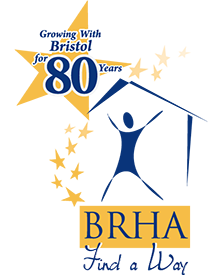Neighborhood Improvements
Be a Catalyst for Neighborhood Improvement
In January 2008 the BRHA Board of Commissioners adopted a set of Long-Term Strategic Objectives to provide context and guidance for future decisions about BRHA operations. (More on our Strategic Plan can be found here.) One of those Strategic Objectives states our intent to be a Catalyst for Neighborhood Improvement in Bristol.
There are several neighborhoods in Bristol with evidence of physical deterioration or blight that would benefit from intervention strategies. With few resources for neighborhood revitalization efforts available to BRHA we have considered how we can make an impact on this need. Read below how we determined BRHA’s role in neighborhood revitalization in Bristol.
Our units are a commanding presence in the Virginia Hill Neighborhood. We recognize that how we manage and maintain these rental units, and improvement decisions we might make regarding major renovations or redevelopment of sites have a significant impact on the vitality, desirability and viability of the neighborhood. Improvements BRHA makes on its publicly-owned properties will have a positive influence on the neighborhood. So, with few dollars and with a vested interest in the neighborhood in which our affordable housing is located, BRHA has made the strategic decision that we focus our neighborhood revitalization efforts in the Virginia Hill Neighborhood.
There is interdependence between improvement efforts by public and private market entities; both are needed to support major neighborhood revitalization. In order to facilitate revitalization of the neighborhood, as a whole, a certain degree of public investment in privately held parcels may be required. This could be in several forms, including providing low-cost resources to private property owners and redevelopment of key parcels by public entities.
- Moore Street Corridor Small Area Plan (2010)
This report provides an analysis of the Moore Street corridor in Bristol, Virginia, and recommends improvements to enhance the corridor’s vitality as a gateway neighborhood to downtown Bristol. These improvements strengthen the character of the Moore Street Corridor by redesigning key entryways into the corridor, improving streetscapes, linking greenways, addressing blight, and upgrading transportation and parking in the corridor. The Urban Development Project Studio at Virginia Tech conducted the corridor study. A team of 17 Virginia Tech Urban and Regional planning graduate students, supervised by Dr. Ted Koebel, reviewed existing conditions in the corridor and developed recommendations responsive to goals identified by the City of Bristol Planning Department. Recommendations include action and implementation strategies to visually enhance the corridor, improve pedestrian safety, increase natural amenities, and increase access to transportation and parking. - LEAD! Bristol 2012 – Friends of Virginia Hill Study (resident needs)
The Friends of Virginia Hill is associated with the Bristol Chamber of Commerce’s LEAD! Bristol leadership program, and is part of the community service project required for class graduation. At the request of the Bristol Redevelopment and Housing Authority, The Friends of Virginia Hill was tasked to solicit resident and stakeholder feedback from the Virginia Hill neighborhood and report candid responses back to City officials. The Friends of Virginia Hill, however, is independent of the Bristol Redevelopment and Housing Authority and all City of Bristol departments and agencies.
- LEAD! Bristol 2013 – Virginia Hill Project (property needs)
In 2012 a LEAD Bristol! Team designed a series of neighborhood input opportunities that allowed Virginia Hill Neighborhood residents the opportunity to share their concerns and dreams for their neighborhood. This effort was an outstanding success that not only gathered vital information and significant participation from residents, but also garnered both public and local government attention and support. A second vital component in our efforts to develop a Virginia Hill Neighborhood Revitalization Project is to conduct a Community Survey that assembles data about existing properties in the neighborhood. To this end the 2013 LEAD Bristol! Team designed a survey instrument and conducted a visual, physical survey of all neighborhood properties, such that resulting data can be readily analyzed, summarized, and mapped from a variety of perspectives (e.g., occupancy status, property condition, ownership type, etc.).
- BRHA Housing Design Study (2012)
In 2012 BRHA commissioned the Cope Architectural firm from Knoxville, TN, to prepare a housing design study that would serve two purposes: 1) to provide building and apartment design alternatives for the proposed Bonham Circle Redevelopment Project based on the “Big House” design model, and 2) to provide infill housing design alternatives of a size and character that could be used for infill construction on vacant lots in the Virginia Hill Neighborhood.
In late 2012 BRHA became aware of a number of properties in the Virginia Hill Neighborhood that were either actively for sale or were being auctioned for tax liens. Reviewing these potential acquisitions in the context of BRHA’s Strategic Plan, earlier studies that had been performed and its prior decisions to focus BRHA’s neighborhood revitalization efforts, the Board of Commissioners made additional policy decisions to guide our activities in neighborhoods.
In January 2013 the Board determined that the Moore Street corridor should be our initial area of concentration and approved three targeted focus areas from the 400- to the 700-block of Moore Street. (See Moore St Corridor Map) During the course of 2013, BRHA acquired 11 parcels in Focus Area A, primarily in the 600 and 700 blocks of Moore Street (click on the addresses for additional information):
- 601 Moore Street: This property was gifted to BRHA from the City of Bristol following its acquisition and demolition of the burned out house on the lot.
- 617 Moore Street: BRHA acquired this apartment building in an open market sale. There are five apartments in the building which were initially rented to Virginia Intermont College students. With the closing of VIC, these units have been opened to the market for rental and frequently house voucher holders from our rental assistance programs.
- 700-Block of Moore Street:
 BRHA acquired these lots from various owners in open market transactions. We own all of the parcels on the east side of the 700-block. Since acquiring them we have demolished the abandoned houses that were on two of the lots. The land is currently maintained as green space. We are currently reviewing options for development of this vacant land.
BRHA acquired these lots from various owners in open market transactions. We own all of the parcels on the east side of the 700-block. Since acquiring them we have demolished the abandoned houses that were on two of the lots. The land is currently maintained as green space. We are currently reviewing options for development of this vacant land.

